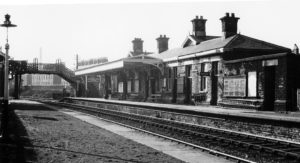Why lines were built and why they were shut have been of great interest to our speaker for much of his life and on Thursday night Alan Young came to talk about his hobby. Being a Geordie he first became interested in railway lines and stations in Heaton near Newcastle, that was in 1972 however by 1981 there was nothing left of this branch as it had been replaced by the metro.
Of course we lose railway stations usually when the lines are closed down and to date there are over 2,000 stations that have been closed down since they were built. Some of these would have been built in the mid 1800’s. Many different companies competed for business whether this was for transporting goods such as coal or the passengers that came along afterwards, apparently South Wales was a tangle of railways (what with the coal mines an’

Great Harwood. 1952. Courtesy of John Mann Collection
all boyo). The advent of trams and the motor car and then double decker buses reduced passenger transport and probably goods transport too and around 1921 there was surge of railway closures. However it was Mr Beechings plan “The Reshaping of British Railways” in 1963 that led to the nine thousand stations being reduced to two thousand. His plan was to stem large losses as increasing competition from road transport reduced income for the railways. Beeching’s cuts decimated some railways in the local area such as the Colne to Skipton and the line to Fleetwood. We are lucky that the Burnley or Preston to Colne line is still open apparently there is a campaign afoot to reopen the Colne to Skipton line.
Piquantly Beeching didn’t get all his sums right. Originally the line from Skipton to Leeds was planned for closure, however it remains open and is apparently the most profitable route outside SW England! Alongside the closures some lines were identified for significant investment.
Alan mentioned two private lines, one to Whittingham Hospital near Preston where patients and staff used the line and one at Holme Chapel in Cliviger used by the family at Holme Hall. The Townley Arms at Longridge was a public house attached to the station there and was restored in 2008 as a heritage and community centre by Heritage lottery funding. Of course the other Townley Arms that is familiar to us lies on the Bacup road in Cliviger. Another well restored building is the station master’s house at Conishead Priory on the old line to Barrow.
It was poignant to be reminded of the small stations or halts that were lost locally such as Bott Lane, Padiham, Simonstone, Reedley Halt and New Hall street stations, some of them barely more than a post and some hard standing.
Did you know?
That Manchester Central was known as the St Pancras of the North.
That originally the station at Blackpool North was to close and the Central station was to keep open but the council had other ideas and applied to keep Blackpool North open, the Central and South Stations closing. The land at Central station has still not been developed but provides visitor parking and a good route straight into the town centre following the old railway line.
That Bott Lane the nearest station to Barrowford near the old Nelson Grammar school was heaving with people whenever there was a match at Turf Moor in Burnley.
That Portsmouth station near Todmorden (now defunct) apparently got its name from a high ranking seaman who on retiring from the the navy bought some fields in the area and named them after naval bases.
That we were lucky to have in the audience that night Eddie Bobrowski who is very well known for his excellent photos of trains in the UK and we were lucky to see one of his excellent photos.
That without the legacy of John Mann who left thousands of photos, which were nearly lost, we would not be able today to view so much of the past history of the railways.
Banner Image: Withnell Station, 17th April 1077. Attribution: Alan Young.